
19th Amendment
The right of citizens of the United States to vote shall not be denied or abridged by the United States or by any State on account of sex.
Congress shall have power to enforce this article by appropriate legislation.
Beginning in the mid-19th century, several generations of woman suffrage supporters lectured, wrote, marched, lobbied, and practiced civil disobedience to achieve what many Americans considered a radical change in the Constitution – guaranteeing women the right to vote. Some suffragists used more confrontational tactics such as picketing, silent vigils, and hunger strikes. - National Archives
It is now time to celebrate and build on the heritage of the women’s suffrage movement.
The following links were compiled to help you learn more about Women's Right to Vote and the actions of those who fought for this right.
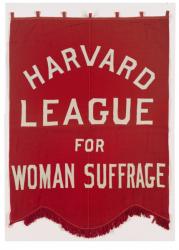 This 19th Amendment resource is housed at the Radcliffe Institute for Advanced Study at Harvard University. It is dedicated to creating and sharing transformative ideas across the arts, humanities, sciences, and social sciences. The Schlesinger Library of the Radcliffe Institute documents the lives of women of the past and present and furthers the Radcliffe Institute’s commitment to women, gender, and society. This suffrage related site includes archival resources of Susan B. Anthony, Alice Stone Blackwell, and Alice Paul. It also includes a link to Harvard University Library site on Women Working, 1800-1930.
This 19th Amendment resource is housed at the Radcliffe Institute for Advanced Study at Harvard University. It is dedicated to creating and sharing transformative ideas across the arts, humanities, sciences, and social sciences. The Schlesinger Library of the Radcliffe Institute documents the lives of women of the past and present and furthers the Radcliffe Institute’s commitment to women, gender, and society. This suffrage related site includes archival resources of Susan B. Anthony, Alice Stone Blackwell, and Alice Paul. It also includes a link to Harvard University Library site on Women Working, 1800-1930.
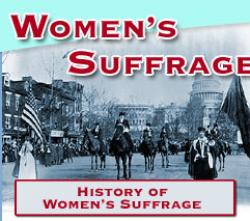 Scholastic's Women's Suffrage allows you to learn about the quest by women around the world to win the right to vote. You can explore and analyze maps and dates as well as have a chance to make a personal connection by reading a firsthand account of a woman who voted for the first time in 1920. (Teacher resources)
Scholastic's Women's Suffrage allows you to learn about the quest by women around the world to win the right to vote. You can explore and analyze maps and dates as well as have a chance to make a personal connection by reading a firsthand account of a woman who voted for the first time in 1920. (Teacher resources)
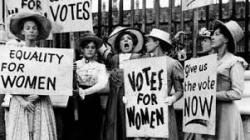 Women Suffrage and the 19th Amendment is a resource that includes documents that contain primary sources. (Teacher resources)
Women Suffrage and the 19th Amendment is a resource that includes documents that contain primary sources. (Teacher resources)
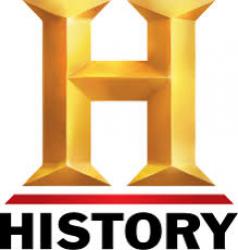 This History Channel site begins with a short video on the history of the 19th Amendment. It is followed by a Table of Contents that includes the following: Women’s Suffrage, Seneca Falls Convention, Declaration of Sentiments, National Suffrage Groups Established, Carrie Chapman Catt, Protest and Progress, The Final Struggle, and When Did Women Get the Right to Vote? These sites include additional videos, pictures, and information on the various topics. (Teacher resources)
This History Channel site begins with a short video on the history of the 19th Amendment. It is followed by a Table of Contents that includes the following: Women’s Suffrage, Seneca Falls Convention, Declaration of Sentiments, National Suffrage Groups Established, Carrie Chapman Catt, Protest and Progress, The Final Struggle, and When Did Women Get the Right to Vote? These sites include additional videos, pictures, and information on the various topics. (Teacher resources)
 The National Constitution Center in Philadelphia, serves as America’s leading platform for constitutional education and debate, fulfilling the organization's congressional charter “to disseminate information about the United States Constitution on a nonpartisan basis in order to increase awareness and understanding of the Constitution among the American people." Information about the 19th Amendment can be found here. It includes the common interpretation of the 19th Amendment, as well as two debates on issues regarding the amendment: What the fourteenth and nineteenth amendments changed for women by Nancy Gertner and Did the nineteenth amendment modify the fourteenth? by Gail Heriot. (Teacher resources)
The National Constitution Center in Philadelphia, serves as America’s leading platform for constitutional education and debate, fulfilling the organization's congressional charter “to disseminate information about the United States Constitution on a nonpartisan basis in order to increase awareness and understanding of the Constitution among the American people." Information about the 19th Amendment can be found here. It includes the common interpretation of the 19th Amendment, as well as two debates on issues regarding the amendment: What the fourteenth and nineteenth amendments changed for women by Nancy Gertner and Did the nineteenth amendment modify the fourteenth? by Gail Heriot. (Teacher resources)
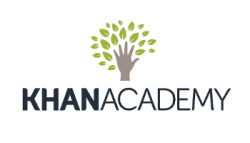 Khan Academy offers videos for people of all ages. The 19th Amendment is discussed, background stated, and questions. (Teacher resources)
Khan Academy offers videos for people of all ages. The 19th Amendment is discussed, background stated, and questions. (Teacher resources)
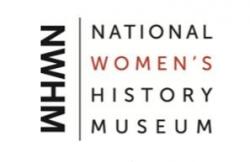 Crusade for the Vote is part of the National Women’s Museum. This site includes the history of Women’s Suffrage, Educational resources, multiple videos, and primary sources (many photographs, posters, and various documents). this site also includes online exhibits, including a slide show titled: Creating a Female Political Culture. (Teacher resources)
Crusade for the Vote is part of the National Women’s Museum. This site includes the history of Women’s Suffrage, Educational resources, multiple videos, and primary sources (many photographs, posters, and various documents). this site also includes online exhibits, including a slide show titled: Creating a Female Political Culture. (Teacher resources)
 Delaware and the 19th Amendment is about the state of Delaware ratifying the 19th Amendment: March 6, 1923. This site contains the story of Delaware’s ratification of the amendment and many links to additional information from this era in our country’s history. These include a link to Women’s History. Information here is presented by the National Park Service.
Delaware and the 19th Amendment is about the state of Delaware ratifying the 19th Amendment: March 6, 1923. This site contains the story of Delaware’s ratification of the amendment and many links to additional information from this era in our country’s history. These include a link to Women’s History. Information here is presented by the National Park Service.
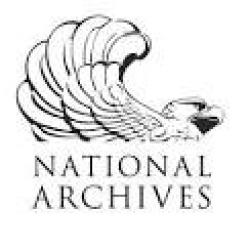 Extending Suffrage to Women: Finding a Sequence is a DocsTeach resource site created by the National Archives that houses many primary sources - letters, photographs, speeches, posters, maps, videos, and other document types. Along with the resources, DocsTeach presents various activities that allow the reader to use these documents as they learn about specific topics. In this activity, you will see eleven different documents arguing both for and against the right to vote for women. The reader then put them in the correct chronological order that they were created. (Teacher resources)
Extending Suffrage to Women: Finding a Sequence is a DocsTeach resource site created by the National Archives that houses many primary sources - letters, photographs, speeches, posters, maps, videos, and other document types. Along with the resources, DocsTeach presents various activities that allow the reader to use these documents as they learn about specific topics. In this activity, you will see eleven different documents arguing both for and against the right to vote for women. The reader then put them in the correct chronological order that they were created. (Teacher resources)
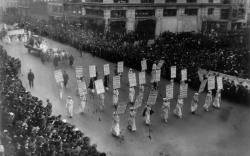 American Women is a resource from the Library of Congress. Spanning all time periods and embracing many occupations, the Library's manuscript sources for the study of women's history are among the finest and most comprehensive in the country. Hundreds of documents are part of collections reflecting the full range of women's experiences. Collections include topics indicating the emphasis of women’s role in the areas listed: Women's Suffrage, Reform, Education, Health and Medicine, Science, Papers of Presidents and First Ladies, Congressional Collections, Legal Collections, Military and Diplomatic Affairs, Literature and Journalism, Artists, Architects, and Designers, Actresses and Actors.
American Women is a resource from the Library of Congress. Spanning all time periods and embracing many occupations, the Library's manuscript sources for the study of women's history are among the finest and most comprehensive in the country. Hundreds of documents are part of collections reflecting the full range of women's experiences. Collections include topics indicating the emphasis of women’s role in the areas listed: Women's Suffrage, Reform, Education, Health and Medicine, Science, Papers of Presidents and First Ladies, Congressional Collections, Legal Collections, Military and Diplomatic Affairs, Literature and Journalism, Artists, Architects, and Designers, Actresses and Actors.
 This guide compiles information from the Library of Congress. It includes the Introduction to the collections, Digital Collections, Online Resources, External Websites, and Print resources.
This guide compiles information from the Library of Congress. It includes the Introduction to the collections, Digital Collections, Online Resources, External Websites, and Print resources.
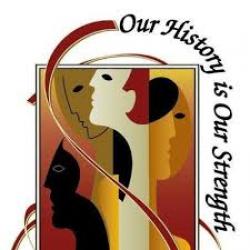 As part of the National Women’s History Project archives at the University of Maryland, this is a list of 75 Suffragettes with a brief descrption of their roles. Also included are: Taking a New Look at the Woman Suffrage Movement, A Few Important Dates from the Women’s Suffrage Movement. The Men behind the Women… (some far-sighted men), And They Still Persevered…A Brief History (written for the 75th anniversary of women suffrage).
As part of the National Women’s History Project archives at the University of Maryland, this is a list of 75 Suffragettes with a brief descrption of their roles. Also included are: Taking a New Look at the Woman Suffrage Movement, A Few Important Dates from the Women’s Suffrage Movement. The Men behind the Women… (some far-sighted men), And They Still Persevered…A Brief History (written for the 75th anniversary of women suffrage).
 Also from the National Women’s History Alliance are three PDF documents that relate today’s stance on the 100th Anniversary, as well as a two-part history of how women earned the right to vote in this country (Part 1 and Part 2). These documents include text, graphics, and links to additional information.
Also from the National Women’s History Alliance are three PDF documents that relate today’s stance on the 100th Anniversary, as well as a two-part history of how women earned the right to vote in this country (Part 1 and Part 2). These documents include text, graphics, and links to additional information.
Quiz
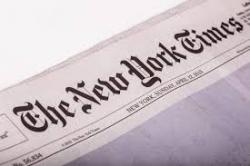 What do you know about the fight for women’s right to vote? Find out by taking this New York Times ten-question quiz.
What do you know about the fight for women’s right to vote? Find out by taking this New York Times ten-question quiz.